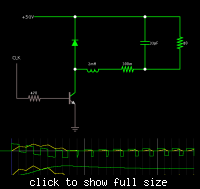boylesg
Advanced Member level 4
- Joined
- Jul 15, 2012
- Messages
- 1,023
- Helped
- 5
- Reputation
- 10
- Reaction score
- 6
- Trophy points
- 1,318
- Location
- Epping, Victoria, Australia
- Activity points
- 11,697
Building on my efforts with the charge pump based voltage booster, here is an attempt at converting it to an inductor based one.
Reason....because I know how to invert a standard trany multivibrator such that it still works with a negative voltage input but I was not able to invert other types of multivibrator circuits for what ever reason.
So I am trying to take the best part of my circuit and match it with the inductor part of other circuits.
Here it is:
But why does the voltage shoot up to about 20V and then slowly decay back to 11V?
Oh......the load on the output is simply a 100R resistor and an LED.
Reason....because I know how to invert a standard trany multivibrator such that it still works with a negative voltage input but I was not able to invert other types of multivibrator circuits for what ever reason.
So I am trying to take the best part of my circuit and match it with the inductor part of other circuits.
Here it is:
But why does the voltage shoot up to about 20V and then slowly decay back to 11V?
Oh......the load on the output is simply a 100R resistor and an LED.
